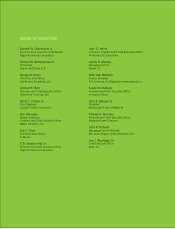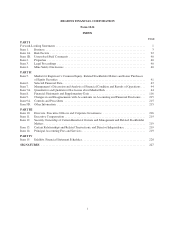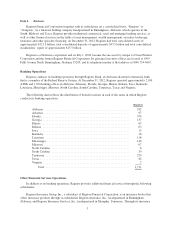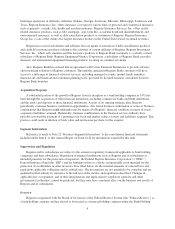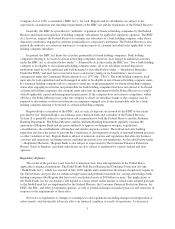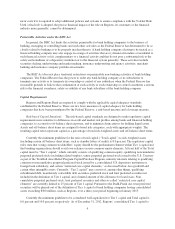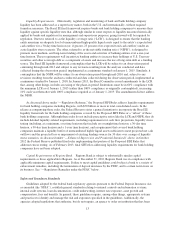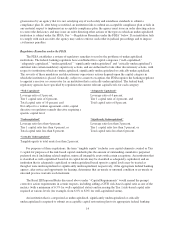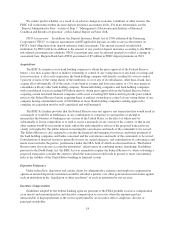Regions Bank 2012 Annual Report Download - page 24
Download and view the complete annual report
Please find page 24 of the 2012 Regions Bank annual report below. You can navigate through the pages in the report by either clicking on the pages listed below, or by using the keyword search tool below to find specific information within the annual report.costly resolution, and analyses of the financial company’s organization, material entities, interconnections and
interdependencies, and management information systems, among other elements. The two “living will” rules are
complementary.
Consumer Financial Protection Bureau. The Dodd-Frank Act created the Consumer Financial Protection
Bureau (the “CFPB”), a new consumer financial services regulator. The CFPB is directed to prevent unfair,
deceptive and abusive practices and ensure that all consumers have access to fair, transparent, and competitive
markets for consumer financial products and services. The Dodd-Frank Act gives the CFPB authority to enforce
and issue rules and regulations implementing existing consumer protection laws and responsibility for all such
existing regulations. Depository institutions with assets exceeding $10 billion, such as Regions Bank, their
affiliates, and other “larger participants” in the markets for consumer financial services (as determined by the
CFPB) are subject to direct supervision by the CFPB, including any applicable examination, enforcement and
reporting requirements the CFPB may establish.
Orderly Liquidation Authority. The Dodd-Frank Act creates the Orderly Liquidation Authority (“OLA”), a
resolution regime for systemically important non-bank financial companies and their non-bank affiliates,
including bank holding companies, under which the FDIC may be appointed receiver to liquidate such a
company if, among other conditions, the company is in danger of default and presents a systemic risk to U.S.
financial stability. This determination must come after supermajority recommendations by the Federal Reserve
and the FDIC and consultation between the Secretary of the U.S. Treasury and the President. This resolution
authority is generally based on the FDIC resolution model for depository institutions, and substantial differences
exist between the rights of creditors under the U.S. Bankruptcy Code and in an orderly liquidation authority
proceeding including the ability of the FDIC to disregard the strict priority of creditor claims in some
circumstances, the use of an administrative claims procedure to determine creditors’ claims (as opposed to the
judicial procedure utilized in bankruptcy proceedings), and the ability of the FDIC to transfer claims to a
“bridge” entity. In addition, OLA limits the ability of creditors to enforce contractual cross-defaults against
potentially viable affiliates of the institution in receivership.
An Orderly Liquidation Fund will fund OLA liquidation proceedings through borrowings from the Treasury
Department and risk-based assessments made, first, on entities that received more in the resolution than they
would have received in liquidation to the extent of such excess, and second, if necessary, on bank holding
companies with total consolidated assets of $50 billion or more, such as Regions. If an orderly liquidation is
triggered, Regions could face assessments for the Orderly Liquidation Fund. We do not yet have an indication of
the level of such assessments.
U.S. Department of Treasury’s Assessment Fee Program. In December 2011, the U.S. Department of the
Treasury (“U.S. Treasury”) issued a proposed rule to implement Section 155 of the Dodd-Frank Act. Section 155
requires the U.S. Treasury to establish an assessment schedule for bank holding companies with total
consolidated assets of $50 billion or more. The rule became effective for bank holding companies on July 20,
2012, and, under the program, Regions is required to pay assessments on a semiannual basis to cover expenses
associated with the Office of Financial Research, the FSOC, and the FDIC’s Orderly Liquidation Authority.
Regions believes the assessment will not be material to its consolidated financial position, results of operations or
cash flows.
Volcker Rule. The Dodd-Frank Act requires the federal financial regulatory agencies to adopt rules that
prohibit banks and their affiliates from engaging in proprietary trading and investing in and sponsoring certain
unregistered investment companies (defined as hedge funds and private equity funds). The statutory provision is
commonly called the “Volcker Rule.” In October 2011, federal regulators proposed rules to implement the
Volcker Rule that included an extensive request for comments on the proposal, which comment period closed in
February 2012. The proposed rules are highly complex, and, because final rules have not yet been adopted, many
aspects of their application remain uncertain. Based on the proposed rules, Regions does not currently anticipate
that the Volcker Rule will have a material effect on the operations of Regions and its subsidiaries. Regions may
8


